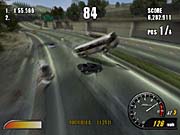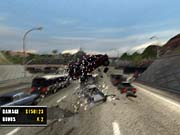Lately, the driving genre has been getting more and more crowded. Across all platforms, we're starting to see a lot more racing games, and each one has tried to do something different. Burnout 2's take on the genre is one of outright speed. The Xbox version of the game is being billed as a "developer's cut" of sorts, adding new cars and stages that haven't appeared in other versions of the game, as well as online scoreboards. But with or without these cool additions, Burnout 2 remains the fastest-moving street racing game in the world and delivers the easy yet incredibly fun driving mechanics you'd expect from an arcade-style racer.

Like its predecessor, Burnout 2 cuts right to the chase. There's no fancy storyline to be found here. The game simply breaks it down into a couple of different modes. At the outset, you'll have to complete a brief training session that successfully fills you in on how to steer, powerslide, and drive recklessly enough to keep your burn meter full at all times. This tutorial will take around five minutes to complete, and it does a nice job of explaining the rules of the road. From here, the standard single race and championship modes are open. Championship racing is the key to unlocking new tracks and cars, which can then, of course, be used in the game's other modes. The meat of the championship objectives are multiple-track tournaments, and while getting a first-place finish every time is the only way to unlock everything, you can struggle along with second- and third-place finishes here and there and still see most of what the game has to offer. You'll also unlock one-on-one races against other cars. Winning these will unlock your opponent's vehicle for use. The pursuit courses work a lot like Taito's classic arcade driving game Chase H.Q. You're put in a police car, and you must ram a fleeing vehicle into submission before it gets away by crossing the course's finish line. The variety in the championship mode makes it a joy to play, because you'll always be unlocking something new and exciting.
The other main mode in Burnout 2 is simply called crash. The original Burnout was lauded for its incredible crash physics--so much so that the Xbox version of the game even let you save your crashes to the system's hard drive. Yet while the crashes looked great in the original, they simply got in the way while you were racing and eventually grew tiresome. The crash mode in Burnout 2 adds a method to the madness by assigning dollar values to the damage you cause in each level. The object is to cause the most gruesome multiple-car pileup possible, and the game keeps a running tab for you to remind you of just how much damage you've caused by plowing full-speed into the side of a bus or a big rig. While the first couple of crash levels are pretty straightforward, the later areas become more of a puzzle, challenging you to crash into the proper car at the proper angle to cause the most damage possible. One level, for example, has you racing toward two lanes of stopped traffic while a collection of buses enters the freeway from a right-hand on-ramp. You need to hit the rear end of the traffic jam just right in order to send your car flying up and over the cars, hopefully landing on that on-ramp and wrecking as many expensive buses as possible. While crash mode isn't terribly complex, it showcases Burnout 2's crash physics amazingly well, letting you see each painfully realistic-looking collision in slow motion as numerous vehicles slam into each other, causing buses to roll and semi trucks to jackknife in the process. As you can probably imagine, the crash mode provides plenty of wicked thrills, and as a bonus, the Xbox version of the game features a ton of new crash levels to play through, which lends some more replay value to an already-packed game.
Burnout 2 has very tight control, which is an absolute necessity, given the high-speed nature of the game. It sticks to a few simple mechanics--gas, brake, turbo, shifting (if you decide to go with a manual transmission), and, sure enough, your horn. The courses are filled with law-abiding traffic, and the only way to fill up your boost meter is to drive recklessly. Near misses with other cars, driving on the wrong side of the road, powersliding, and catching air are all things that will fill up your boost bar. Once it's full, you can hit the boosters, which engages a The Fast and the Furious-style nitrous effect that makes the road seem like it's stretching out. If you continue to drive in a dangerous manner without actually crashing, you might even score a second boost bar immediately after your first is drained. Indeed, if you're sharp enough on the road, it's conceivable that you could simply boost your way through the entire race. But once you really get moving, staying safe becomes much more difficult.
Burnout 2 keeps track of a lot of different stats as you race, including high scores, fastest times, number of burnouts, and longest skid. With an Xbox Live account, you can upload your achievements to a master high-score list. Obviously, real online racing would have been a great addition to an already-great game, but Burnout 2's online scoreboard is a nice touch, considering the game's arcadelike nature.
While graphics are usually judged on their own terms, the graphics in Burnout 2 are so well done that they actually make the gameplay better. The game moves incredibly quickly and maintains a firm, smooth frame rate throughout. You need to keep your eyes on the road when you're really cooking, because the traffic comes up suddenly, and you have to react just as quickly. Simply put, the sense of speed delivered by Burnout 2 is nearly unmatched. But the rest of the graphical presentation holds up its end of the bargain as well. The game's car models look very good. The textures used throughout the game are simply great, and the various lighting effects create the illusion of the sun reflecting off your car and the pavement quite nicely. The Xbox version of the game also has progressive scan support, a definite plus for owners of higher-end televisions.

The game's sound, which supports Dolby Digital 5.1, is great. While it doesn't really take full advantage of its surround sound support, there are a few nice touches, such as the Doppler effect of sirens dropping in pitch as the police cars speed off into the distance and a collection of different engine noises for the different cars. The stock car in the game even emits a satisfying "hissy thunk" sound as it shifts from gear to gear. Meanwhile, the music is typical car-chase stuff that sounds like it would fit right into any modern action movie, though none of it particularly stands out. The music changes somewhat depending on what's happening, in that it stays in the background most of the time but pumps up and becomes a bit more frantic when you activate your turbo boost. You can use a custom soundtrack, but the interactive music effects obviously aren't available when you do so.
In the end, Burnout 2 isn't terribly different from the original Burnout--it just makes significantly better use of all the elements that the game does well, from its blistering sense of speed to its hilariously destructive crashes. The crash mode alone makes this game worth seeing, and the inclusion of the well-done championship and multiplayer modes makes it the best pure arcade-style racing game available on the Xbox.